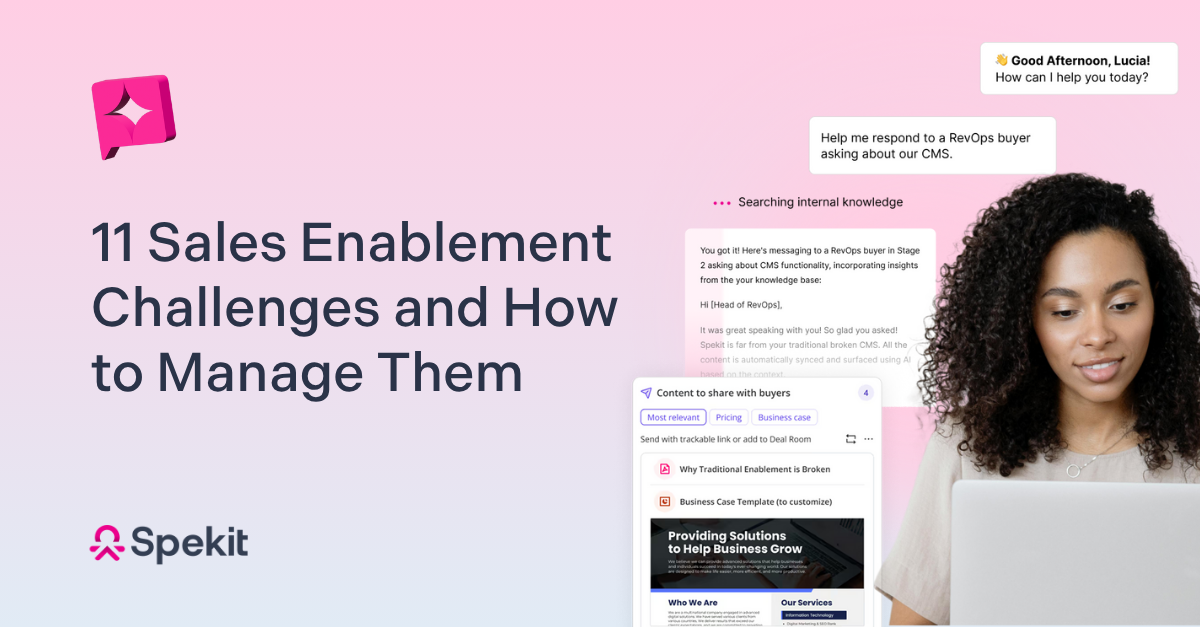A strong sales enablement strategy is vital to maximizing every sales touchpoint, from improving ramp time to shortening sales cycles to increasing revenue. Yet, roughly one-third of companies with a sales enablement program still need to consistently meet their sales enablement goals.
This isn’t exactly surprising, though, given how many elements have to come together to get a sales enablement strategy off the ground and thriving. Each element brings with it potential sales enablement challenges that, left unchecked, can trap your sales team in underperformance mode.
Let’s unpack the biggest sales enablement challenges—guided by enablement experts Stephanie Middaugh, Head of Global GTM Enablement at Pinecone, and Alex Mislan, Vice President of Product Strategy at Sales Assembly—to keep on your radar and exactly how to tackle them.
What Makes Sales Enablement So Complex?
What makes sales enablement so complex are some of the same things that make it exciting. The primary culprits? Sales enablement’s status as a relatively new discipline—combined with how demanding it is.
“There’s just not enough time, and maybe even appetite, for all the things that need to be done,” says Alex Mislan of Sales Assembly. Between ongoing product launches, ever-changing processes, and endless opportunities to level up your skills, “It’s this consistent game of fatigue with training, alongside the need for progress.”
This is further intensified by the need for intricate collaboration between sales teams and marketing departments to ensure:
- New reps are onboarded quickly and efficiently
- Reps have easy access to top-notch sales collateral
- Sellers know exactly what content to use and when
- Sales pipeline stages are as friction-free as possible
- Training is happening in just the right amounts, at just the right time
- Seller performance is tracked to pinpoint where they need to improve
- Sales enablement strategies stay aligned with company goals
And that’s just a Tuesday.
Adds Mislan: “Armed with that never-ending list of things, you have to continually go back to the drawing board and ask yourself: What’s feasible? What’s actually going to make a difference with where our business needs to go right now?”
In other words, no pressure.
Biggest Sales Enablement Challenges and How to Manage Them
With every sales and revenue enablement program comes its own series of sales enablement challenges. The sooner you notice them brewing, the fewer frustrations your sales team will run into during their day-to-day.
Let’s learn from the experts on how to manage these challenges and create a stronger sales enablement strategy.
- It’s a new, growing field
Even though sales enablement is a relatively new field, it’s already one of the most critical to a company’s success. As a result of its lightning-fast growth, companies don’t yet have a unified, working definition of sales enablement, and many sales teams are left struggling to keep up with its rapid evolution.
How to approach this sales enablement challenge
The one silver lining to sales enablement having an open-ended definition is that you can create your own that’s custom-fit to your company, versus using some generic sales enablement program template and hoping for the best. As a starting point, you can explore free online sales enablement tools to test workflows and identify what features your team might need long-term.
Mislan recommends defining what success looks like and backwards-mapping your vision into specific milestones you need people to hit within their roles that align with this vision.
“You want to get everyone productive as soon as possible,” she explains. “So what does productivity mean in each role, exactly? Then milestone those things out, giving each of them information as needed so they can hit the ground running.”
- Often combines sales, marketing, customer success, and more
Revenue enablement teams—sales, marketing, customer success, support—have intersecting roles, yet often function in silos. This disconnect can cause major problems, such as marketing creating sales collateral that sales team don’t need or sales not knowing how to use the collateral being provided to them.
How to approach this sales enablement challenge
Effective sales enablement requires efficient cross-functional collaboration. The best way to align teams and streamline communication is to centralize enablement within a unified platform like Spekit. Spekit is the modern AI-powered enablement solution that connects content management, training, and personalized guidance in one place. It combines contextual learning, analytics, and cross-functional visibility to keep revenue teams aligned and productive across every touchpoint.
- Managing constant change requires consistent, effective training
“The markets are shifting so drastically and quickly that it’s nearly impossible to keep up,” says Stephanie Middaugh of Pinecone. “The most challenging thing for me is: How can I focus on something long enough to get it out to the teams that’s still relevant to them by the time I put it in front of them?”
And, once you put the updates and changes in front of them, you still have to get past the training fatigue of it all. “People’s attention spans are shorter than ever,” says Middaugh. They’ve got so much going on already that getting their attention long enough for even the things they know they need is a constant uphill battle, she adds.
How to approach this sales enablement challenge
Managing the constant changes—and turning them into your reps’ new go-to habits—requires ongoing sales enablement training and coaching, including access to free sales training programs that boost core skills without added cost. But not in the form of lengthy PDFs or workshops—instead, through bite-sized, easily digestible intel that’s folded directly into the flow of work.
Using Spekit AI, you can instantly generate and update playbooks, tool definitions, and sales scripts, then with AI Sidekick, you can surface them automatically in the tools your reps already use, such as Salesforce, Gmail, and Slack.
On top of step-by-step walkthroughs that take reps through new tools and processes, you can use Spekit to assess your team’s progress and improve retention by delivering knowledge checks right where they’re working.
And thanks to Spekit’s rapid authoring capabilities, you can quickly and easily make updates to your knowledge base and notify reps directly in the flow of work so they’re never out of the loop—and their productivity is never disrupted.
- Needs leadership alignment and buy-in
One of the biggest sales enablement challenges you’ll probably come across is getting leadership approval—and you can’t build a sales enablement program without executive buy-in.
“There are still some minds that need to be shifted around where enablement sits and how it influences the work,” says Mislan. Still, sales enablement programs ultimately “need to come from the top down in order to be truly successful.”
How to approach this sales enablement challenge
If there isn’t a culture of learning established in the company, Mislan recommends pushing up on leadership and helping them understand what that means and why it’s important.
“Enablement has evolved to a place where it’s a necessity for there to be a seat at the table and decision-influencing ability from that seat,” Mislan says. Get them on board by speaking their language: Tell them exactly how the program will benefit the company and the expected ROI.
- There may be resistance to change
Introducing new sales enablement tools and strategies disrupts the status quo for the better. But some reps might resist these changes, fearing a loss of efficiency or perceived additional workload.
How to approach this sales enablement challenge
Instead of making big, sweeping changes every so often, incorporate continuous learning into your sales team’s repertoire. With sales playbook software that solves enablement challenges like Spekit, you can:
- Instantly notify reps of time-sensitive changes, new resources, and key announcements
- Trigger in-app alerts and guidance exactly when and where changes take place
- Share best practice vids or training resources when reps start a process for the first time
By making change a series regular, your team can confidently embrace shifts in strategy, knowing that whenever they have a question, the answer is only a click or hover away.
- Content repositories are disconnected
Sales professionals incorporating sales enablement content in their approach are 58% more likely to exceed their targets. However, the disconnect between content repositories acts as a significant hurdle.
The majority of reps spend a whopping 3-11 hours per week searching for answers to questions about tools, processes, or information. Over half of reps will go to their sales manager for information before searching content management tools—and who can blame them?
How to approach this sales enablement challenge
Centralizing your content is the first step. The next is to put that content into measurable action. How? By meeting your reps where they are.
“Where are your teams? Is it a Slack message? Is it an email?” says Middaugh. “Ask yourself: How can I best put the information in front of them in the way they tend to learn best? And how can you do that with potentially dozens of reps, who all learn a little differently?”
Spekit unifies your sales collateral, playbooks, and FAQs in one intelligent content hub that integrates directly into tools like Salesforce, Slack, and Outreach. This ensures the right content surfaces at the right time without requiring reps to switch between platforms.
- You must determine specific sales enablement responsibilities
Another of the trickier sales enablement challenges is the lack of clear insights into what the roles and responsibilities of sales enablement even are. This lack of clarity can cause confusion and inefficiency—not to mention missed opportunities. Implementing a structured sales knowledge management system can help ensure teams have access to well-documented processes, reducing uncertainty and improving efficiency.
It can also cause major scope creep. “It can be really easy to get pulled into places where maybe you don’t have L&D at your organization, but you do have enablement, so all of a sudden you’re the onboarder for everyone,” says Mislan. “You end up adding responsibilities to your bucket that ultimately aren’t feasible for one person or one department.”
How to approach this sales enablement challenge
Define the scope of your sales enablement team to make sure your stakeholders understand what you are and aren’t responsible for, including specific sales performance metrics.
“One of the things I’ve seen people have smashing success with is being really candid about the scope of their work and what they’re covering and then documenting and sharing that in the business so people are aware,” says Mislan. You also have something to reference when co-workers, undoubtedly, come to you with tasks or projects outside the scope of your role.
- Takes time to prove clear success
Measuring the impact of sales enablement programs is complicated. Sales enablement tasks intersect with multiple stages of the buyer’s journey, so traditional metrics (think: deal size and revenue) don’t tell the whole story.
“There are too many components that can influence the data,” says Mislan. “It’s really hard to isolate and attach enablement efforts to something specific, like an increase in revenue.” But measuring the KPIs you can is still valuable, she adds, because someone is inevitably going to want data to back up how effective you are at what you’re doing.
How to approach this sales enablement challenge
Mislan recommends taking a step back and highlighting what’s working. “It may not always be a closed deal,” she says. “It might be that someone found an innovative way to prospect or a new way to do discovery.” Talk about why it went well and be clear what you want to see from a leadership or teammate perspective of what other people can do through that person’s example.
Adds Mislan: “Trying to win the battles you can with measurement and making sure you’re controlling as much of that as you possibly can so you have evidence that the work you’re doing is sufficient for the business you serve.”
Spekit Analytics transforms engagement data into actionable insights so enablement leaders can understand which content drives performance, identify coaching opportunities, and replicate top-performer behaviors across the team. Real-time feedback and usage data make it easy to see what’s resonating and where to improve.
- Consistently changing markets requires continuous re-prioritization
Buyer behavior is constantly evolving, and your sales enablement program needs to keep up. Somehow. “We’ve seen pullback from some of the more long-term long tail skill development and a move toward very short-term thinking,” says Mislan. “In the market we’re in today, you just don’t have the time on the horizon to succeed that you used to.”
How to approach this sales enablement challenge
To make sure reps are consistently updated on shifts in market trends and changes in customer preferences, continuous training is where it’s at—it has the potential to increase net sales per rep by up to 50%.
“Reps want to know the best thing they can implement tomorrow that’s going to help them close a deal, save a customer, whatever it is,” says Mislan. “Provide them with the bite-sized tips and tricks or new information that helps them move forward, and hopefully, see success.”
Another thing: “Don’t add to the noise that’s already buzzing around their heads,” says Middaugh. “Understand what warrants a legitimate training behavior change initiative and what’s just an FYI footnote.”
- Can require complex technical integrations
When companies roll out new sales intelligence software solutions and tool integrations, research shows those efforts fail 70% of the time. The problem? Too much focus on the launch and too little on how to train, reinforce, and communicate change post-rollout.
How to approach this sales enablement challenge
“Instead of teaching reps all of the features of your tech stack, show them how to use the functionality of the tool in the context of how they’ll actually use it on the job,” says Mislan. “This helps to get people to stick and be productive with that information, rather than having to go reference it.”\
Spekit integrates seamlessly with your existing tech stack, embedding personalized guidance and resources directly into the tools your team uses every day. There’s no complex setup or code required.
- Effective data analytics is a must
Data-savvy businesses are 162% more likely to significantly surpass their revenue goals when compared to more passive companies. Yet, almost half of sellers say some of their toughest challenges are incomplete data and unclear analysis, which creates more questions than answers.
How to approach this sales enablement challenge
If your data isn’t cutting it, get to the bottom of why—say, by nailing down what you hope to extract from the data first. Example: “Define what ramp is for your business and your teams,” says Middaugh. “What does it mean when a rep is ramped? And then how do you actually define what success looks like for those reps?”
From there, determine your company’s unique sales enablement metrics and the changes that need to be made to how your data is collected and reported.
Grow Your Sales Enablement Team’s Success
Sales enablement challenges are inevitable but manageable with the right strategy and tools. Spot them early, stay aligned, and deliver enablement where your team works to keep revenue moving.
Spekit helps revenue teams do just that by unifying content, training, and personalized guidance in one AI-powered platform. With contextual delivery through AI Sidekick, reps get the right answers and insights exactly when they need them without ever leaving their workflow.







